Spatial-Temporal Monitoring of Water Quality in Rural Property Enrolled in a Program for Payment for Environmental Water Services (PES-Water)—A Case Study in Brazil
Abstract
1. Introduction
2. Materials and Methods
2.1. Study Area
2.2. Methodology
3. Results and Discussion
3.1. Spatial-Temporal Variability on Water Oxygen, Temperature, and pH
3.2. Spatial-Temporal Variability of Water Electrical Conductivity, Turbidity, Total Dissolved Solids, Total Phosphorus, and Total Nitrogen
4. Conclusions
Author Contributions
Funding
Data Availability Statement
Acknowledgments
Conflicts of Interest
References
- Araújo, I.S.; Maciel, A.B.C.; Ferreira, J.C.V.; Lima, Z.M.C. Identificação de serviços ecossistêmicos na praia de Ponta Negra, Natal-RN. Rev. Geociências Do Nordeste 2018, 4, 298–313. [Google Scholar] [CrossRef]
- Burkhard, B.; Kandziora, M.; Hou, Y.; Müller, F. Ecosystem service potential, flows and demands-concepts for spatial localisation, indication and quantification. Landsc. Online 2014, 34, 1–32. [Google Scholar] [CrossRef]
- Castro, B.S.; Young, C.E.F.; Pereira, V.S. Iniciativas estaduais de Pagamentos por Serviços Ambientais: Análise legal e seus resultados. Rev. Iberoam. Econ. Ecológica 2018, 28, 44–71. [Google Scholar]
- Mamedes, I.; Guerra, A.; Rodrigues, D.B.B.; Garcia, L.C.; de Faria Godoi, R.; Oliveira, P.T.S. Brazilian payment for environmental services programs emphasize water-related services. In International Soil and Water Conservation Research; KeAi Communications Co.: Beijing, China, 2023; Volume 11, pp. 276–289. [Google Scholar] [CrossRef]
- Gregori, M.S. Limites e possibilidades do sistema de Pagamento por Serviços Ambientais como instrumento de promoção da sustentabilidade socioambiental no Brasil. Ph.D. Thesis, Universidade Federal de Santa Maria, Santa Maria, Brazil, 2017. [Google Scholar]
- Calvet-Mir, L.; Corbera, E.; Martin, A.; Fisher, J.; Gross-Camp, N. Payments for ecosystem services in the tropics: A closer look at effectiveness and equity. Curr. Opin. Environ. Sustain. 2015, 14, 150–162. [Google Scholar] [CrossRef]
- Huang, Y.; Zhang, X.; Sheng, X.; Wang, Y.; Leung, K.M.Y. The impact of payment for ecosystem service schemes on participants’ motivation: A global assessment. Ecosyst. Serv. 2024, 65, 101595. [Google Scholar] [CrossRef]
- Martin-Ortega, J.; Ojea, E.; Roux, C. Payments for water ecosystem services in Latin America: A literature review and conceptual model. Ecosyst. Serv. 2013, 6, 122–132. [Google Scholar] [CrossRef]
- Grima, N.; Singh, S.J.; Smetschka, B.; Ringhofer, L. Payment for ecosystem services (PES) in Latin America: Analysing the performance of 40 case studies. Ecosyst. Serv. 2016, 17, 24–32. [Google Scholar] [CrossRef]
- Chiodi, R.E.; Marques, P.E.M. Políticas públicas de pagamento por serviços ambientais para a conservação dos recursos hídricos: Origens, atores, interesses e resultados da ação institucional. Desenvolv. E Meio Ambiente 2018, 45, 81–104. [Google Scholar] [CrossRef]
- Jardim, M.H.; Bursztyn, M.A. Pagamento por serviços ambientais na gestão de recursos hídricos: O caso de Extrema (MG). Eng. Sanit. Ambient. 2015, 20, 353–360. [Google Scholar] [CrossRef]
- Guedes, F.B.; Seehusen, S.E. (Eds.) O PSA na Mata Atlântica—Situação Atual, Desafios e Recomendações; Ministério do Meio Ambiente: Brasília, Brazil, 2011. [Google Scholar]
- Balvanera, P.; Uriarte, M.; Almeida-Leñero, L.; Altesor, A.; DeClerck, F.; Gardner, T.; Hall, J.; Lara, A.; Laterra, P.; Peña-Claros, M.; et al. Ecosystem services research in Latin America: The state of the art. Ecosyst. Serv. 2012, 2, 56–70. [Google Scholar] [CrossRef]
- Arriagada, R.A.; Sills, E.O.; Ferraro, P.J.; Pattanayak, S.K. Do payments pay off? Evidence from participation in Costa Rica’s PES program. PLoS ONE 2015, 10, e0131544. [Google Scholar]
- Bennett, G.; Carroll, N. Gaining Depth: State of Watershed Investment 2014; Forest Trends: Washington, DC, USA, 2014; Available online: https://www.foresttrends.org/publications/gaining-depth-2/ (accessed on 13 March 2020).
- Ureta, J.U.; Ureta, J.C.; Bower, L.M.; Peoples, B.K.; Motallebi, M. The value of improving freshwater ecosystem services: South Carolina residents’ willingness to pay for improved water quality. J. Environ. Manag. 2024, 353, 120260. [Google Scholar] [CrossRef] [PubMed]
- Campinas. Lei no. 15.046 de 23 de Julho de 2015. Institui o Programa de Pagamento por Serviços Ambientais, Autoriza o Poder Executivo Municipal a Prestar Apoio aos Proprietários Rurais e Urbanos Determinados pelo Programa, e dá Outras Providências. Campinas, SP. Diário Oficial do Município. Available online: https://portal-api.campinas.sp.gov.br/sites/default/files/publicacoes-dom/dom/2062178756.pdf (accessed on 17 September 2024).
- Campinas. Decreto Municipal no. 19.441 de 15 de Março de 2017. Regulamenta o Subprograma de Pagamento pela Conservação das Águas e dos Recursos Hídricos-PSA Água, Instituído pela Lei nº 15.046, de 23 de Julho de 2015. Campinas, SP. Diário Oficial do Município. Available online: https://bibliotecajuridica.campinas.sp.gov.br/index/visualizaroriginal/id/130978 (accessed on 17 September 2024).
- SVDS. Secretaria Municipal do Verde, Meio Ambiente e Desenvolvimento Sustentável. GEOAMBIENTAL: Informações Ambientais Espacializadas. Recuperado em 14 de maio de 2020. Available online: https://geoambiental.campinas.sp.gov.br/pmapper/map_svds.phtml?config=svds (accessed on 17 September 2024).
- Taffarello, D.; do Carmo, C.M.; Viani, R.A.G.; Marengo, J.A.; Mendiondo, E.M. Hydrological services in the Atlantic Forest, Brazil: An ecosystem-based adaptation using ecohydrological monitoring. Clim. Serv. 2017, 8, 1–16. [Google Scholar] [CrossRef]
- Izquierdo-Tort, S.; Alatorre, A.; Arroyo-Gerala, P.; Shapiro-Garza, E.; Naime, J.; Dupras, J. Exploring local perceptions and drivers of engagement in biodiversity monitoring among participants in payments for ecosystem services schemes in southeastern Mexico. Conserv. Biol. 2024, 38, e14282. [Google Scholar] [CrossRef] [PubMed]
- Young, C.E.F.; de Bakker, L.B. Payments for ecosystem services from watershed protection: A methodological assessment of the Oasis Project in Brazil. Nat. Conserv. 2014, 12, 71–78. [Google Scholar] [CrossRef]
- Brownson, K.; Fowler, L. Evaluating how we evaluate success: Monitoring, evaluation and adaptive management in Payments for Watershed Services programs. Land Use Policy 2020, 94, 104505. [Google Scholar] [CrossRef]
- Longo, R.M.; Garcia, J.M.; Gomes, R.C.; Nunes, A.N. Identifying Key Indicators for Monitoring Water Environmental Services Payment Programs—A Case Study in Brazil. Sustainability 2023, 15, 9593. [Google Scholar] [CrossRef]
- Fiore, F.A.; Bardini, V.S.S.; Novaes, R.C. Monitoramento da qualidade de águas em programas de pagamento por serviços ambientais hídricos: Estudo de caso no município de São José dos Campos/SP. Eng. Sanit. Ambient. 2017, 22, 1141–1150. [Google Scholar] [CrossRef]
- Brasil. Conselho Nacional do Meio Ambiente–CONAMA. Resolução CONAMA nº357, de 17 de março de 2005. Dispõe Sobre a Classificação dos Corpos de Água e Diretrizes Ambientais para seu Enquadramento, bem Como Estabelece as Condições e Padrões de Lançamento de Efluentes, e dá Outras Providências; Diário Oficial [da] República Federativa do Brasil: Brasília, Brazil, 2005. [Google Scholar]
- Brasil. Ministério da Saúde. Portaria n°2.914, de 12 de dezembro de 2011. Dispõe Sobre os Procedimentos de Controle e de Vigilância da Qualidade da Água para Consumo Humano e seu Padrão de Potabilidade; Diário Oficial [da] República Federativa do Brasil: Brasília, Brazil, 2011. [Google Scholar]
- Brasil. Ministério da Saúde. Anexo XX: Do Controle e da Vigilância da Qualidade da Água para Consumo Humano e seu Padrão de Potabilidade. Portaria de Consolidação n° 5, de 28 de Setembro de 2017. Consolidação das Normas sobre as ações e os Serviços de Saúde do Sistema Único de Saúde; Diário Oficial [da] República Federativa do Brasil: Brasília, Brazil, 2017. [Google Scholar]
- CIIAGRO. Centro Integrado de Informações Agrometeorológicas. CIIAGRO online. Recuperado em 20 de outubro de 2020. Available online: http://www.ciiagro.sp.gov.br/ciiagroonline/ (accessed on 20 October 2020).
- Valladares Neto, J.; Santos, C.B.; Torres, E.M.; Estrela, C. Boxplot: Um recursos gráfico para a análise e interpretação de dados quantitativos. Rev. Odontológica Do Bras. Cent. 2017, 26, 1–6. [Google Scholar]
- Canteri, M.G. SASM-AGRI: Sistema para análise e separação de médias em experimentos agrícolas pelos métodos Scott-Knott, Tukey e Duncan. Rev. Bras. Agrocomputação 2001, 1, 18–24. [Google Scholar]
- Villa, M.E.C.D.; Sampaio, T.V.M. Variabilidade espacial e temporal dos parâmetros físico-químico em ambiente lêntico. Bol. De Geogr. 2016, 34, 69–80. [Google Scholar] [CrossRef]
- Oliveira, C.N.; Campos, V.P.; Medeiros, Y.D.P. Avaliação e identificação de parâmetros importantes para a qualidade de corpos d’água no semiárido baiano. Estudo de caso: Bacia hidrográfica do Rio Salitre. Química Nova 2010, 33, 1059–1066. [Google Scholar] [CrossRef]
- Poersch, A.C.C.; Sebastien, N.Y.; Taborda, J.; Colombari Neto, J.; Caovilla, M.M.; Fonseca, C.A. A demanda bioquímica de oxigênio (DBO) e possíveis fatores de influência nos processos em águas superficiais do Rio São Francisco Verdadeiro–Paraná. Acta Iguazu 2019, 8, 45–51. [Google Scholar]
- Garcia, J.M.; Longo, R.M. Análise de impactos ambientais em Área de Preservação Permanente (APP) como instrumento de gestão em rios urbanos. Cerrados (UNIMONTES) 2020, 18, 107–128. [Google Scholar] [CrossRef]
- Esteves, F.A. Fundamentos de Limnologia, 2nd, ed.; Editora Interciência: Rio de Janeiro, Brazil, 1998. [Google Scholar]
- Sisinno, C.L.S.; Moreira, J.C. Avaliação da contaminação e poluição ambiental na área de influência do aterro controlado do Morro do Céu, Niterói, Brasil. Cad. De Saúde Pública 1996, 12, 515–523. [Google Scholar] [CrossRef] [PubMed]
- Lamparelli, C.C. Dinâmica da Serapilheira em Manguezais de Bertioga, Região Sudeste do Brasil. Ph.D. Thesis, Universidade de São Paulo, São Paulo, Brazil, 1995. [Google Scholar]
- Von Sperling, M. Introdução à Qualidade das Águas e ao Tratamento de Esgotos, 3rd, ed.; Editora UFMG: Belo Horizonte, Brazil, 2005. [Google Scholar]
- Rocha, H.M.; Cabral, J.B.P.; Braga, C.C. Avaliação espaço-temporal das águas dos afluentes do Reservatório da UHE Barra dos Coqueiros/Goiás. Rev. Bras. De Recur. Hídricos 2014, 19, 131–142. [Google Scholar] [CrossRef]
- Baggio, H.; Freitas, M.O.; Araújo, A.D. Análises dos parâmetros físico-químicos oxigênio dissolvido, condutividade elétrica, potencial hidrogeniônico e temperatura, suas correlações com o uso e ocupação da terra no baixo curso do Rio das Velhas-MG. Caminhos De Geogr. 2016, 17, 105–117. [Google Scholar] [CrossRef]
- Arcova, F.C.S.; Cicco, V. Qualidade da água de microbacia com diferentes usos do solo na região de Cunha, Estado de São Paulo. Sci. For. 1999, 56, 125–134. [Google Scholar]
- Marmontel, C.V.F.; Rodrigues, V.A. Parâmetros indicativos para qualidade da água em nascentes com diferentes coberturas de terra e conservação da vegetação ciliar. Floresta Ambiente 2015, 22, 171–181. [Google Scholar] [CrossRef]
- Donadio, N.M.M.; Galbiatti, J.A.; De Paula, R.C. Qualidade da água de nascentes com diferentes usos do solo na bacia hidrográfica do córrego Rico, São Paulo, Brasil. Eng. Agrícola 2005, 25, 115–125. [Google Scholar] [CrossRef]
- Damasceno, M.C.S.; Ribeiro, H.M.C.; Takiyama, L.R.; De Paula, M.T. Avaliação sazonal da qualidade das águas superficiais do Rio Amazonas na orla da cidade de Macapá, Amapá, Brasil. Ambiente E Água 2015, 10, 598–613. [Google Scholar] [CrossRef][Green Version]
- Branco, C.C.Z.; Krupek, R.A.; Peres, C.K. Variação sazonal de alguns parâmetros físicos e químicos em três rios pertencentes a uma bacia de drenagem na região centro-sul do Estado do Paraná, Sul do Brasil. Acta Sci. Biol. Sci. 2008, 30, 431–438. [Google Scholar] [CrossRef]
- Soares, R.D.B.; Cruz, R.W.L.; Silva, C.E. A influência da precipitação na variabilidade da qualidade da água do rio Parnaíba. Braz. J. Dev. 2019, 5, 16643–16672. [Google Scholar] [CrossRef]
- Fonseca, H.S.; Salvador, N.N.B. Estudo integrado da qualidade das águas da bacia hidrográfica do Rio Bonito em Descalvado-SP. Rev. Do Inst. Adolfo Lutz 2005, 64, 179–185. [Google Scholar] [CrossRef]
- Silva, D.D.; Pruski, F.F.; Schaefer, C.E.G.R.; Amorim, R.S.S.; Paiva, K.W.N. Efeito da cobertura nas perdas de solo em um Argissolo Vermelho-Amarelo utilizando simulador de chuva. Eng. Agrícola 2005, 25, 409–419. [Google Scholar] [CrossRef]
- Vanzela, L.S.; Hernandez, F.B.T.; Franco, R.A.M. Influência do uso e ocupação do solo nos recursos hídricos do Córrego Três Barras, Marinópolis. Rev. Bras. De Eng. Agrícola E Ambient. 2010, 14, 55–64. [Google Scholar] [CrossRef]
- FUNASA. Fundação Nacional de Saúde. Manual Prático de Análise de Água, 4th ed.; FUNASA: Brasília, Brazil, 2013; 150p. [Google Scholar]
- Brasil. Ministério da Saúde. Secretaria de Vigilância em Saúde. Inspeção Sanitária em Abastecimento de Água; Ministério da Saúde: Brasília, Brazil, 2007. [Google Scholar]
- Nunes, L.M. Pesquisa de coliformes totais e termotolerantes no rio Salgadinho no município de Juazeiro do Norte, CE. Rev. Eletrônica Acervo Científico 2019, 7, e2243. [Google Scholar] [CrossRef]
- Santos, E.P.P.; Veiga, W.A.; Gonçalves, M.R.S.; Thomé, M.P.M. Coliformes Totais e Termotolerantes em água de nascentes utilizadas para o consumo humano na zona rural do município de Varre-Sai, RJ. Sci. Plena 2015, 11, 052401. [Google Scholar]
- Scapin, D.; Rossi, E.M.; Oro, D. Qualidade microbiológica da água utilizada para consumo humano na região do extremo oeste de Santa Catarina, Brasil. Rev. Inst. Adolfo Lutz 2012, 71, 593–596. [Google Scholar] [CrossRef]
- Santos, A.A.; Silva, D.P.; Costa, I.A.; Cuba, R.M.F. Avaliação sazonal de índices de estado trófico para fósforo total para mananciais de abastecimento público do Município de Goiânia, Estado do Goiás, Brasil. Rev. Bras. De Gestão Ambient. E Sustentabilidade 2019, 6, 883–895. [Google Scholar] [CrossRef]
- Hossomi, A.M.T. Avaliação Temporal (2006 a 2016) da Qualidade de Água do Ribeirão Anhumas–Campinas/SP; (Monografia de Especialização); Escola Superior de Agricultura Luiz de Queiroz ESALQ/USP: Piracicaba, Brazil, 2017. [Google Scholar]
- Leite, D.A.N.O.; Ramos, M.A.G.; Godói, D.R.; Mariano, A.P.; Pião, A.C.S.; Angelis, D.F. Avaliação dos parâmetros do índice de Qualidade de Água segundo o modelo estatístico ARIMA. HOLOS Environ. 2013, 13, 24–39. [Google Scholar] [CrossRef]
- Souza, F.A.R. Modelagem Espacial da Qualidade da Água Usando Geotecnologias na Bacia Hidrográfica de Santana-RJ. Dissertação de Mestrado, Universidade Federal do Rio de Janeiro, Rio de Janeiro, Brazil, 2017.
- Meyer, S.T.; Franceschinelli, E.V. Influência de variáveis limnológicas sobre a comunidade das macrófitas aquáticas em rios e lagoas da Cadeia do Espinhaço, Minas Gerais, Brasil. Rodriguésia 2011, 62, 743–758. [Google Scholar] [CrossRef]
- Carvalho, A.R.; Marinho, A.M.; Silva, A.C.R.S.; Bernardes, M.E.C. Comparação entre os Índices de Qualidade da Água (IQA) dos estuários dos rios Itamambuca e Juqueriquerê–litoral norte de São Paulo–sob mesma sazonalidade. In Anais do IV Congresso Brasileiro de Gestão Ambiental; IBEAS: Salvador, Brazil, 2013. [Google Scholar]
- Barbieri, E.; Marques, H.L.A.; Bondioli, A.C.V.; Campolim, M.B.; Ferrarini, A.T. Concentrações do nitrogênio amoniacal, nitrito e nitrato em áreas de engorda de ostras no município de Cananeia-SP. O Mundo Da Saúde 2014, 38, 105–115. [Google Scholar] [CrossRef]
- Mota, P.K.; da Costa, A.M.; Prado, R.B.; Fernandes, L.F.S.; Pissarra, T.C.T.; Pacheco, F.A.L. Payment for Environmental Services: A critical review of schemes, concepts, and practice in Brazil. In Science of the Total Environment; Elsevier B.V.: Amsterdam, The Netherlands, 2023; Volume 899. [Google Scholar] [CrossRef]
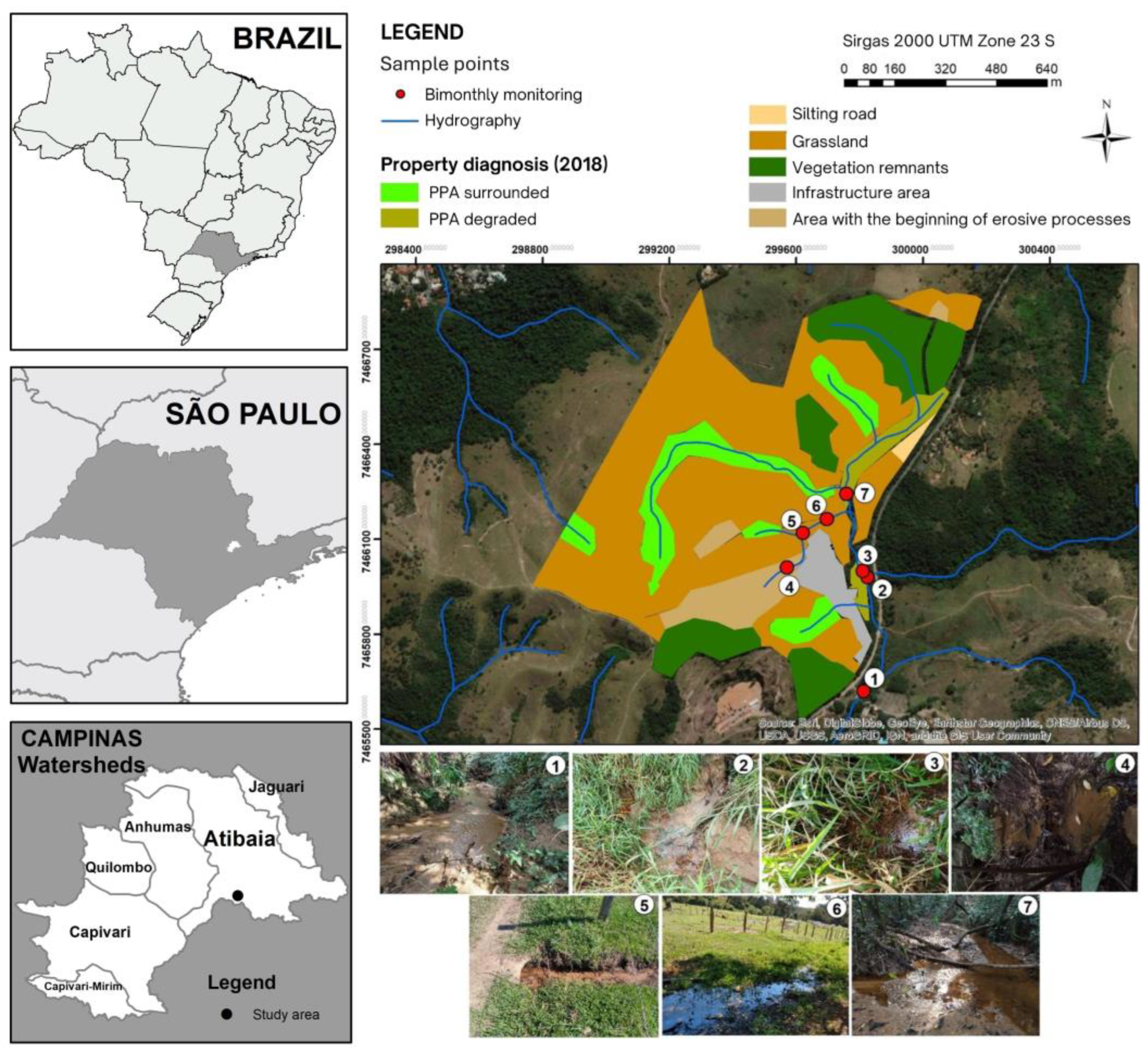
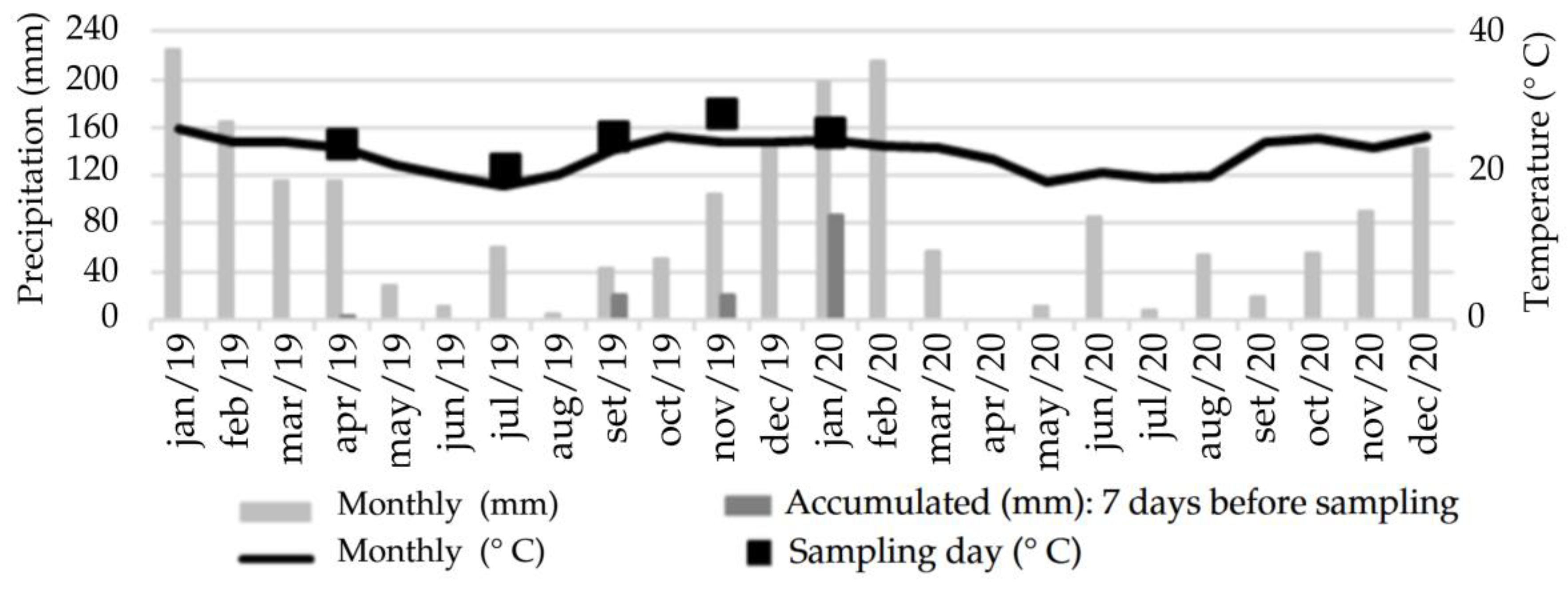
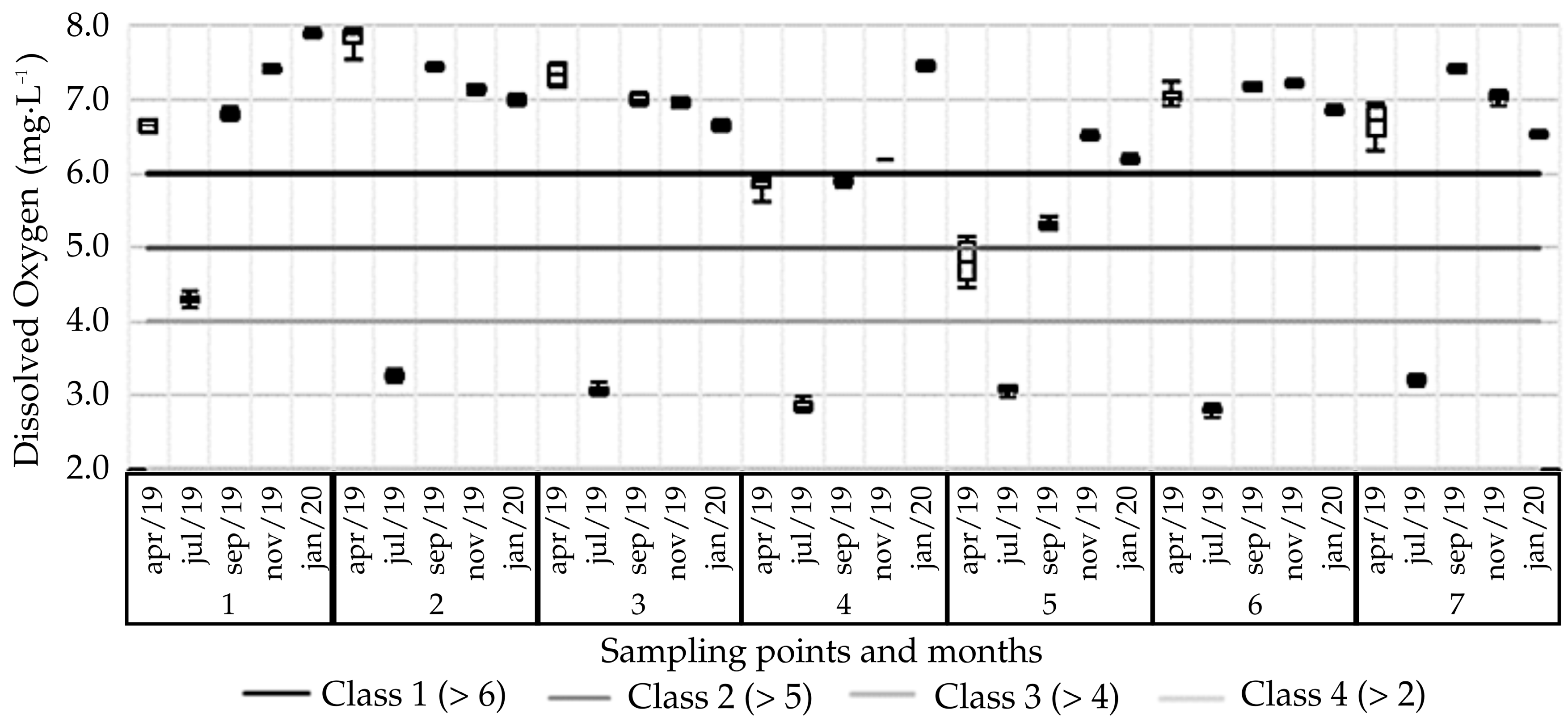
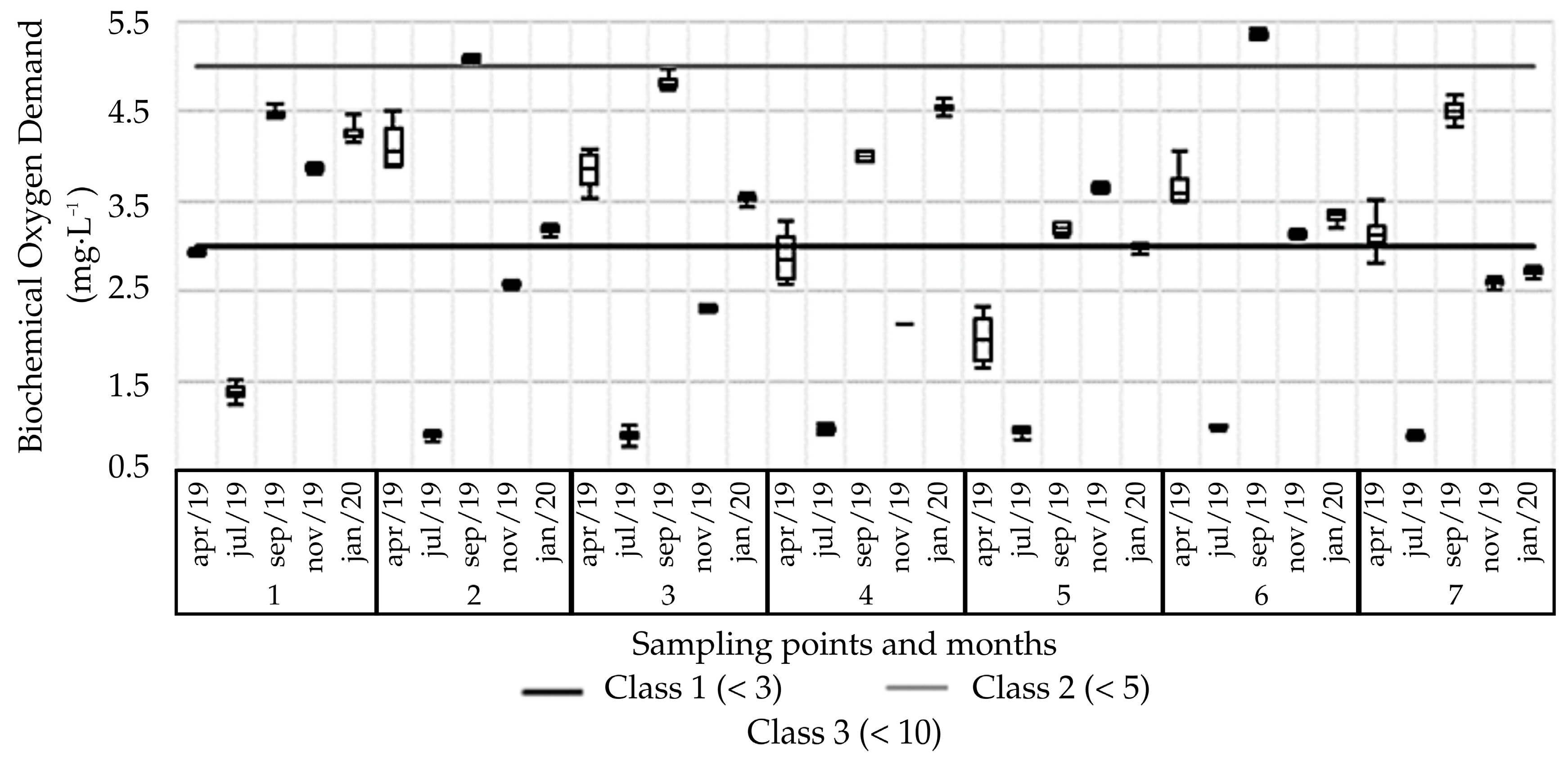
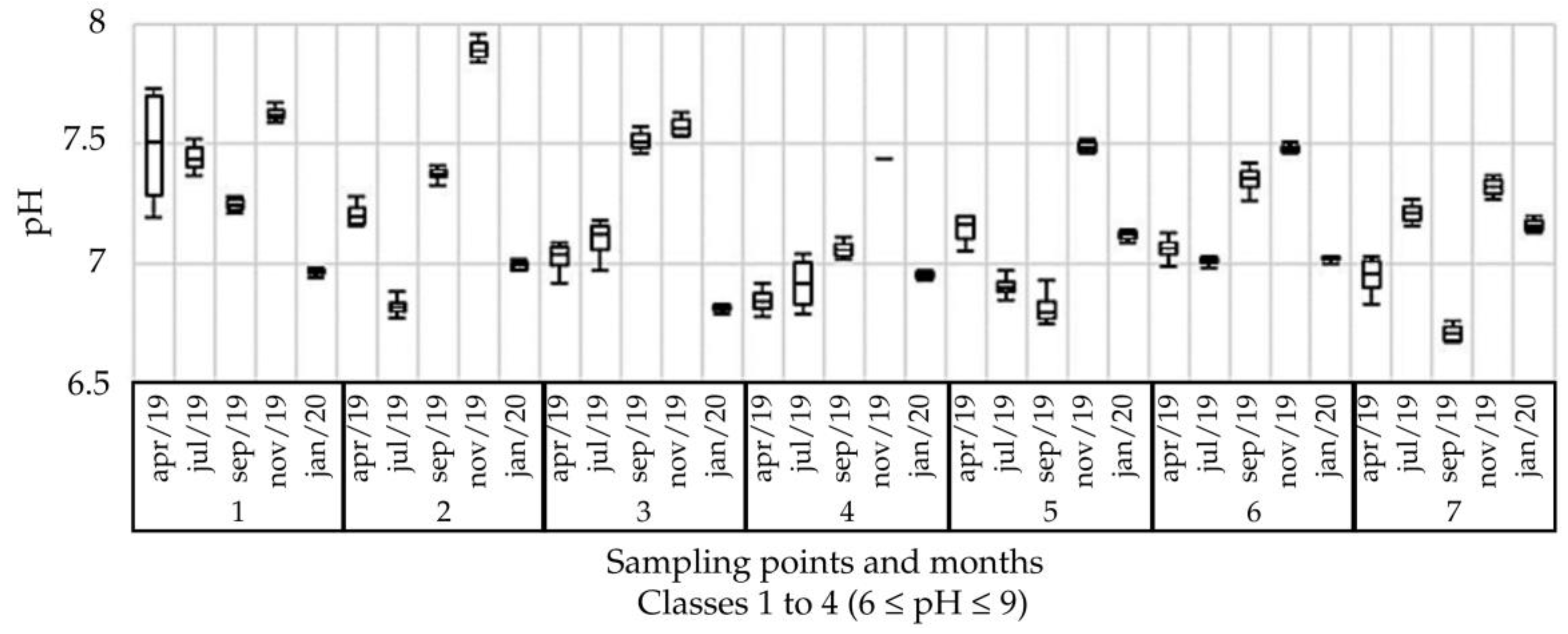
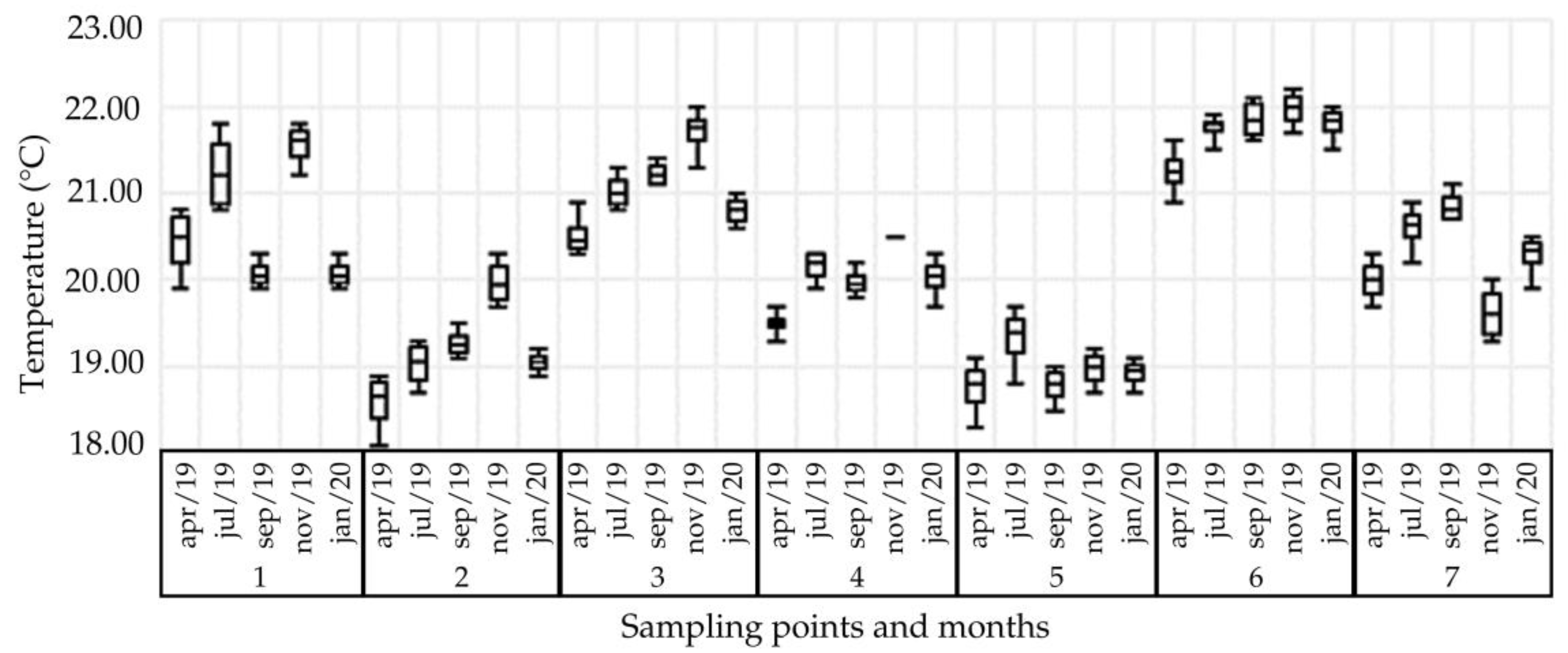
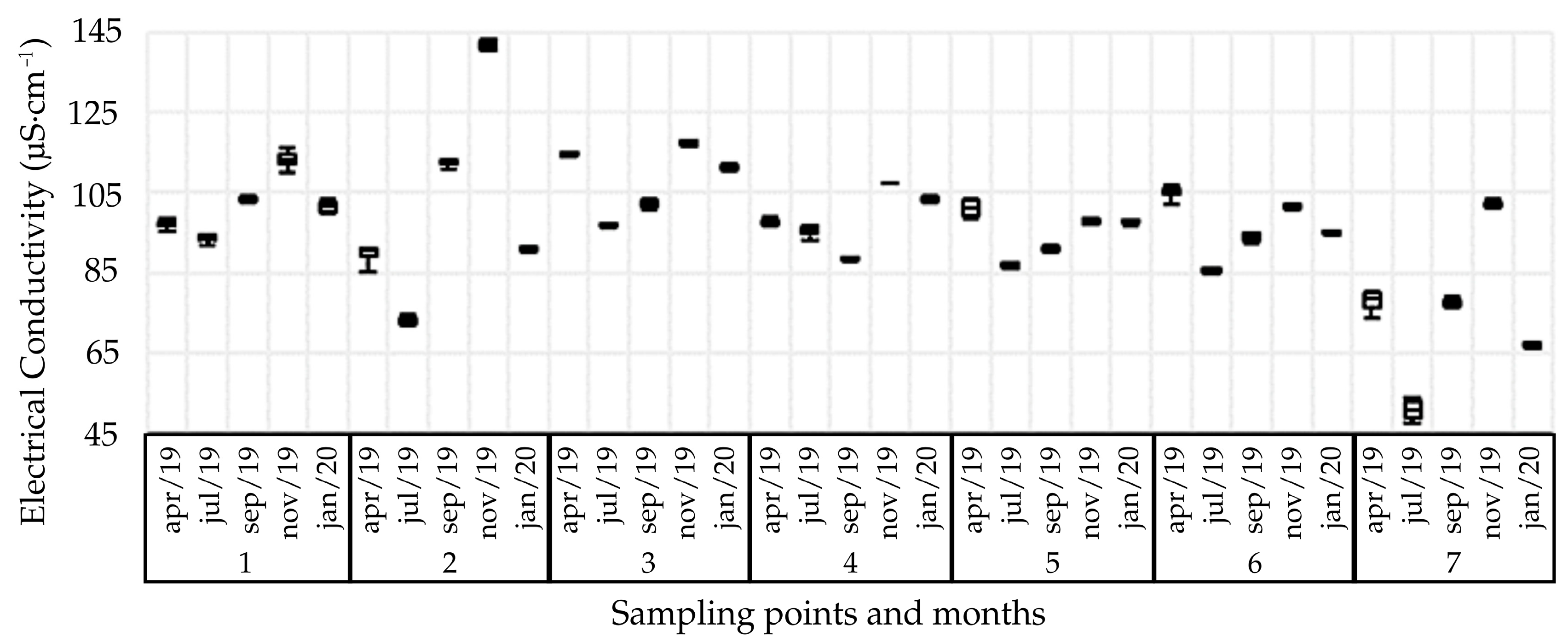
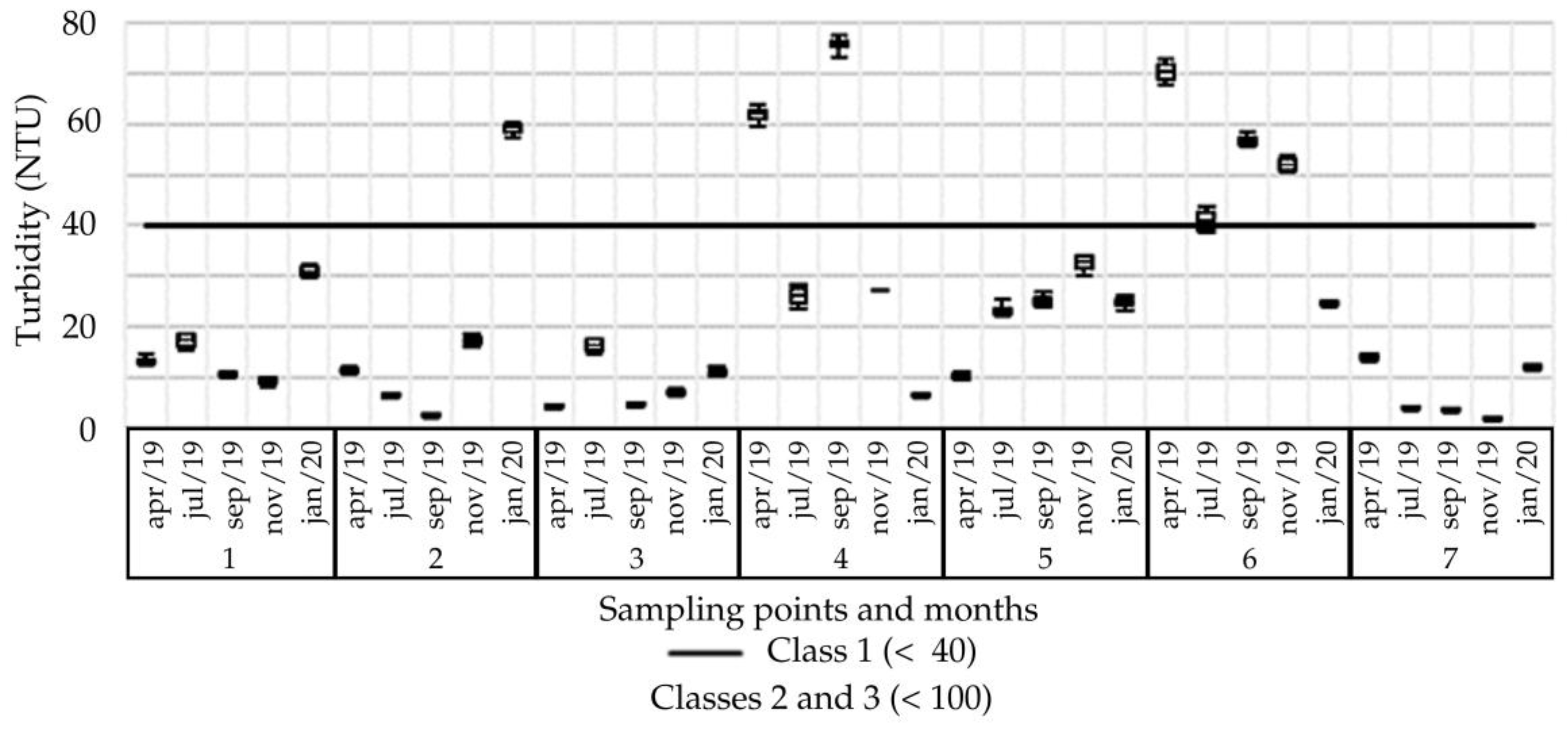
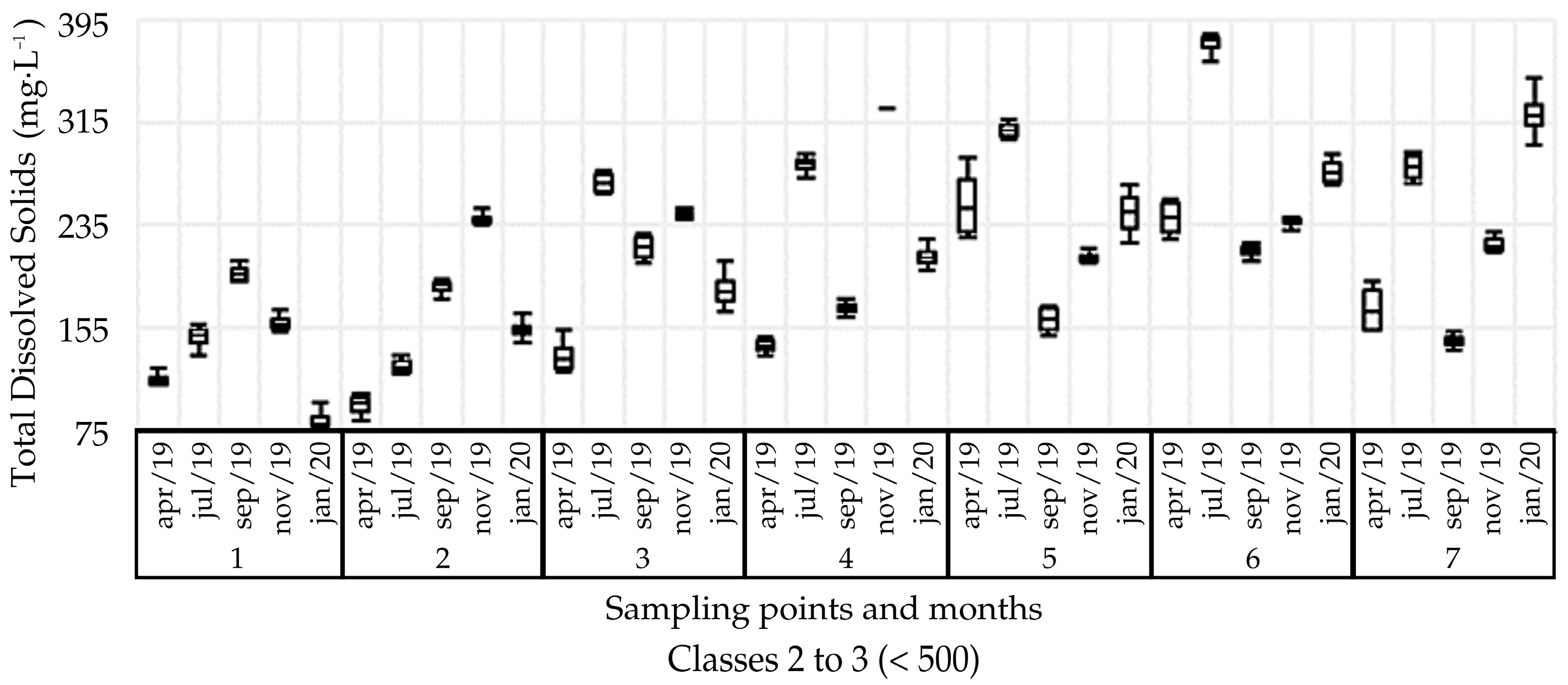
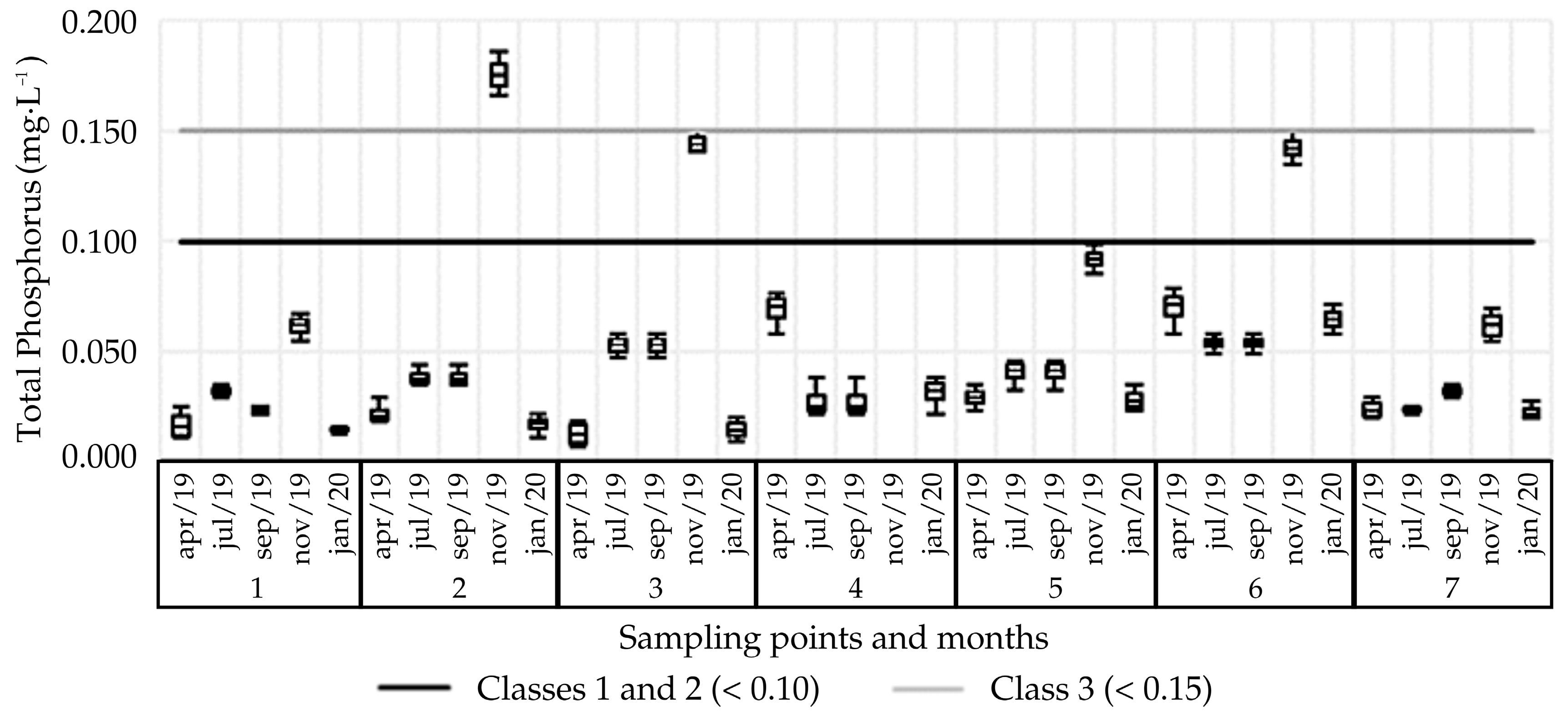
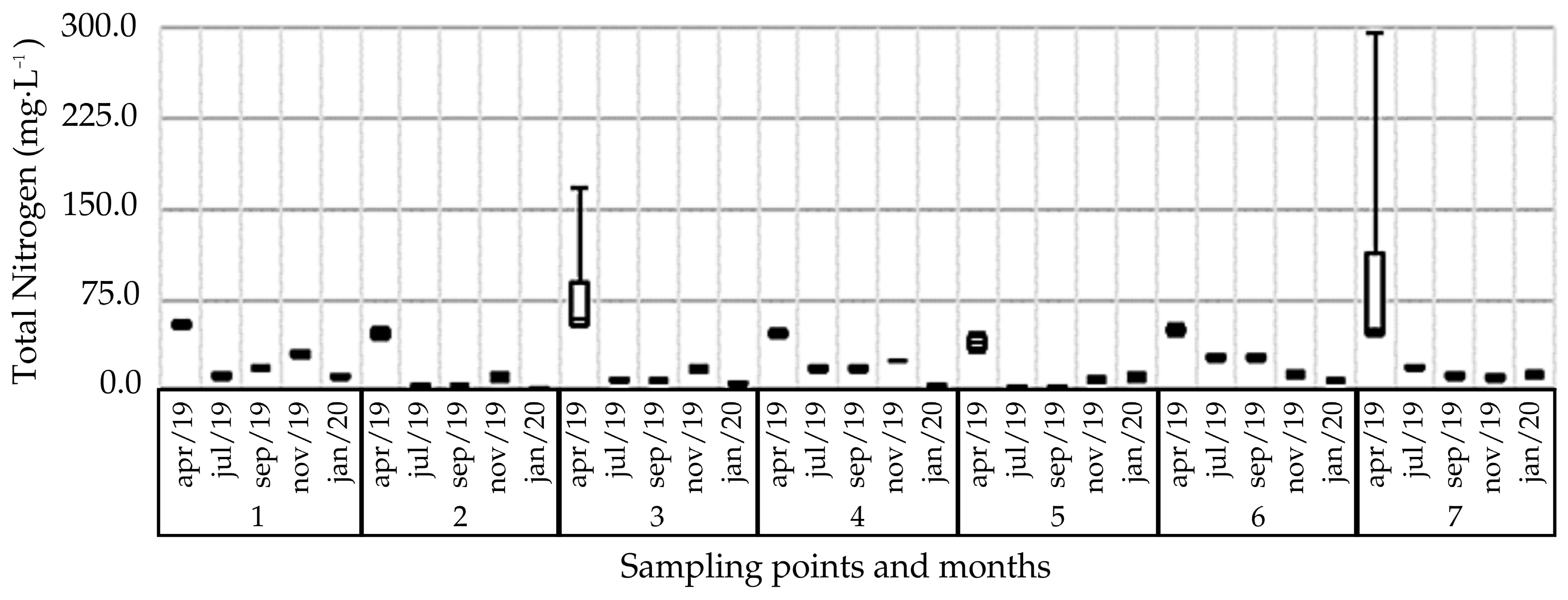
| Point | Apr 2019 | Jul 2019 | Sep 2019 | Nov 2019 | Jan 2020 | Average | SD | CV (%) |
|---|---|---|---|---|---|---|---|---|
| Dissolved Oxygen (mg·L−1) | ||||||||
| 1 | 6.66 cB | 4.30 bB | 6.80 dB | 7.41 aB | 7.89 aB | 6.61 | 1.38 | 20.91 |
| 2 | 7.82 cB | 3.27 bB | 7.44 dB | 7.14 aB | 7.00 aB | 6.53 | 1.85 | 28.36 |
| 3 | 7.33 cA | 3.08 bA | 7.01 dA | 6.96 aA | 6.66 aA | 6.21 | 1.76 | 28.42 |
| 4 | 5.86 cD | 2.86 bD | 5.89 dD | 6.18 aD | 7.45 aD | 5.65 | 1.69 | 29.88 |
| 5 | 4.81 cC | 3.08 bC | 5.33 dC | 6.51 aC | 6.19 aC | 5.18 | 1.36 | 26.21 |
| 6 | 7.06 cA | 2.80 bA | 7.18 dA | 7.23 aA | 6.86 aA | 6.22 | 1.92 | 30.83 |
| 7 | 6.68 cA | 3.21 bA | 7.43 dA | 7.04 aA | 6.52 aA | 6.18 | 1.69 | 27.41 |
| Average | 6.60 | 3.23 | 6.73 | 6.92 | 6.94 | - | - | - |
| SD | 1.00 | 0.50 | 0.81 | 0.43 | 0.58 | - | - | - |
| CV (%) | 15.14 | 15.56 | 12.07 | 6.21 | 8.30 | - | - | - |
| Biochemical Oxygen Demand (mg·L−1) | ||||||||
| 1 | 2.93 cD | 1.38 aD | 4.49 eD | 3.88 bD | 4.28 dD | 3.39 | 1.27 | 37.50 |
| 2 | 4.14 cBC | 0.90 aBC | 5.08 eBC | 2.58 bBC | 3.19 dBC | 3.18 | 1.59 | 49.92 |
| 3 | 3.84 cB | 0.90 aB | 4.83 eB | 2.31 bB | 3.53 dB | 3.08 | 1.52 | 49.17 |
| 4 | 2.90 cA | 0.97 aA | 4.00 eA | 2.13 bA | 4.55 dA | 2.91 | 1.44 | 49.32 |
| 5 | 1.98 cE | 0.95 aE | 3.20 eE | 3.65 bE | 2.99 dE | 2.55 | 1.09 | 42.60 |
| 6 | 3.69 cCD | 0.99 aCD | 5.36 eCD | 3.14 bCD | 3.33 dCD | 3.30 | 1.56 | 47.39 |
| 7 | 3.15 cA | 0.90 aA | 4.51 eA | 2.6 bA | 2.72 dA | 2.78 | 1.30 | 46.65 |
| Average | 3.23 | 1.00 | 4.49 | 2.90 | 3.51 | - | - | - |
| SD | 0.73 | 0.17 | 0.72 | 0.67 | 0.67 | - | - | - |
| CV (%) | 22.51 | 17.37 | 16.08 | 23.16 | 19.11 | - | - | - |
| pH | ||||||||
| 1 | 7.48 abD | 7.44 aD | 7.25 bD | 7.63 dD | 6.96 cD | 7.35 | 0.26 | 3.49 |
| 2 | 7.21 abC | 6.82 aC | 7.37 bC | 7.90 dC | 6.99 cC | 7.26 | 0.41 | 5.70 |
| 3 | 7.02 abBC | 7.10 aBC | 7.51 bBC | 7.57 dBC | 6.81 cBC | 7.20 | 0.33 | 4.54 |
| 4 | 6.85 abA | 6.92 aA | 7.06 bA | 7.44 dA | 6.95 cA | 7.04 | 0.24 | 3.35 |
| 5 | 7.14 abA | 6.91 aA | 6.82 bA | 7.49 dA | 7.12 cA | 7.09 | 0.26 | 3.66 |
| 6 | 7.06 abB | 7.01 aB | 7.35 bB | 7.48 dB | 7.02 cB | 7.18 | 0.22 | 3.02 |
| 7 | 6.95 abA | 7.21 aA | 6.71 bA | 7.32 dA | 7.16 cA | 7.07 | 0.24 | 3.44 |
| Average | 7.10 | 7.06 | 7.15 | 7.55 | 7.00 | - | - | - |
| SD | 0.21 | 0.21 | 0.30 | 0.18 | 0.11 | - | - | - |
| CV (%) | 2.91 | 3.04 | 4.20 | 2.41 | 1.64 | - | - | - |
| Temperature (°C) | ||||||||
| 1 | 20.43 dC | 21.25 bcC | 20.08 abC | 21.55 cC | 20.08 aC | 20.68 | 0.69 | 3.31 |
| 2 | 18.58 dA | 19.03 bcA | 19.28 abA | 19.98 cA | 19.05 aA | 19.18 | 0.51 | 2.67 |
| 3 | 20.53 dD | 21.03 bcD | 21.23 abD | 21.70 cD | 20.80 aD | 21.06 | 0.44 | 2.11 |
| 4 | 19.50 dB | 20.15 bcB | 19.98 abB | 20.50 cB | 20.03 aB | 20.03 | 0.36 | 1.80 |
| 5 | 18.75 dA | 19.33 bcA | 18.78 abA | 18.98 cA | 18.93 aA | 18.95 | 0.23 | 1.22 |
| 6 | 21.25 dE | 21.75 bcE | 21.85 abE | 21.98 cE | 21.80 aE | 21.73 | 0.28 | 1.28 |
| 7 | 20.00 dB | 20.60 bcB | 20.85 abB | 19.63 cB | 20.28 aB | 20.27 | 0.48 | 2.38 |
| Average | 19.86 | 20.45 | 20.29 | 20.61 | 20.14 | - | - | - |
| SD | 0.98 | 1.01 | 1.09 | 1.15 | 0.99 | - | - | - |
| CV (%) | 4.92 | 4.92 | 5.36 | 5.60 | 4.92 | - | - | - |
| Point | Apr 2019 | Jul 2019 | Sep 2019 | Nov 2019 | Jan 2020 | Average | SD | CV (%) |
|---|---|---|---|---|---|---|---|---|
| Electrical Conductivity (μS·cm−1) | ||||||||
| 1 | 97.03 cA | 93.68 bA | 103.40 aA | 113.30 dA | 101.63 aA | 101.81 | 7.48 | 7.35 |
| 2 | 89.40 cA | 73.13 bA | 112.38 aA | 141.83 dA | 91.08 aA | 101.56 | 26.48 | 26.07 |
| 3 | 114.63 cF | 96.88 bF | 102.28 aF | 117.53 dF | 111.43 aF | 108.55 | 8.68 | 8.00 |
| 4 | 97.75 cE | 95.55 bE | 88.33 aE | 107.30 dE | 103.58 aE | 98.50 | 7.35 | 7.46 |
| 5 | 101.20 cC | 87.03 bC | 91.20 aC | 97.95 dC | 97.70 aC | 95.02 | 5.75 | 6.06 |
| 6 | 105.18 cD | 85.80 bD | 94.00 aD | 101.48 dD | 94.98 aD | 96.29 | 7.46 | 7.75 |
| 7 | 77.85 cB | 50.98 bB | 77.73 aB | 102.33 dB | 66.95 aB | 75.17 | 18.74 | 24.93 |
| Average | 97.58 | 83.29 | 95.61 | 111.67 | 95.33 | - | - | - |
| SD | 11.68 | 16.38 | 11.41 | 14.97 | 14.12 | - | - | - |
| CV (%) | 11.97 | 19.67 | 11.93 | 13.41 | 14.81 | - | - | - |
| Turbidity (NTU) | ||||||||
| 1 | 13.37 eC | 17.21 aC | 10.58 dC | 9.30 bC | 30.98 cC | 16.29 | 8.75 | 53.76 |
| 2 | 11.52 eD | 6.51 aD | 2.61 dD | 17.45 bD | 59.08 cD | 19.43 | 22.85 | 117.57 |
| 3 | 4.36 eB | 16.33 aB | 4.56 dB | 7.25 bB | 11.13 cB | 8.73 | 5.06 | 57.93 |
| 4 | 61.80 eF | 26.15 aF | 75.65 dF | 27.20 bF | 6.42 cF | 39.44 | 28.41 | 72.02 |
| 5 | 10.43 eE | 23.45 aE | 25.18 dE | 32.51 bE | 24.90 cE | 23.29 | 8.01 | 34.39 |
| 6 | 70.40 eG | 40.95 aG | 56.68 dG | 52.00 bG | 24.55 cG | 48.92 | 17.24 | 35.24 |
| 7 | 14.11 eA | 4.08 aA | 3.66 dA | 1.68 bA | 11.91 cA | 7.09 | 5.54 | 78.10 |
| Average | 3.23 | 1.00 | 4.49 | 2.90 | 3.51 | - | - | - |
| SD | 0.73 | 0.17 | 0.72 | 0.67 | 0.67 | - | - | - |
| CV (%) | 22.51 | 17.37 | 16.08 | 23.16 | 19.11 | - | - | - |
| Total dissolved solids (mg·L−1) | ||||||||
| 1 | 116.0 aC | 148.0 eC | 198.5 bC | 159.5 dC | 84.5 cC | 141.3 | 43.3 | 30.7 |
| 2 | 95.5 aD | 126.0 eD | 187.5 bD | 240.5 dD | 154.5 cD | 160.8 | 56.1 | 34.9 |
| 3 | 134.5 aB | 268.5 eB | 218.0 bB | 243.5 dB | 185.5 cB | 210.0 | 52.2 | 24.9 |
| 4 | 141.50 aA | 282.5 eA | 171.0 bA | 326.0 dA | 211.0 cA | 226.4 | 76.8 | 33.9 |
| 5 | 253.0 aA | 309.5 eA | 162.0 bA | 210.5 dA | 244.5 cA | 235.9 | 54.5 | 23.1 |
| 6 | 241.0 aE | 376.0 eE | 215.5 bE | 238.0 dE | 277.0 cE | 269.5 | 63.5 | 23.6 |
| 7 | 170.5 aAB | 280.5 eAB | 145.5 bAB | 220.5 dAB | 322.0 cAB | 227.8 | 73.8 | 32.4 |
| Average | 164.6 | 255.9 | 185.4 | 234.1 | 211.3 | - | - | - |
| SD | 60.9 | 88.8 | 27.4 | 49.8 | 79.2 | - | - | - |
| CV (%) | 37.0 | 34.7 | 14.8 | 21.3 | 37.5 | - | - | - |
| Total phosphorus (mg·L−1) | ||||||||
| 1 | 0.02 aA | 0.03 aA | 0.02 aA | 0.06 cA | 0.01 bA | 0.03 | 0.02 | 63.95 |
| 2 | 0.02 aB | 0.04 aB | 0.04 aB | 0.18 cB | 0.02 bB | 0.06 | 0.07 | 114.05 |
| 3 | 0.01 aB | 0.05 aB | 0.05 aB | 0.14 cB | 0.01 bB | 0.06 | 0.05 | 96.62 |
| 4 | 0.07 aE | 0.03 aE | 0.03 aE | 0.31 cE | 0.03 bE | 0.09 | 0.12 | 131.65 |
| 5 | 0.03 aC | 0.04 aC | 0.04 aC | 0.09 cC | 0.03 bC | 0.05 | 0.03 | 57.37 |
| 6 | 0.07 aD | 0.05 aD | 0.05 aD | 0.14 cD | 0.06 bD | 0.08 | 0.04 | 48.51 |
| 7 | 0.02 aA | 0.02 aA | 0.03 aA | 0.06 cA | 0.02 bA | 0.03 | 0.02 | 50.91 |
| Average | 0.03 | 0.04 | 0.04 | 0.14 | 0.03 | - | - | - |
| SD | 0.02 | 0.01 | 0.01 | 0.09 | 0.02 | - | - | - |
| CV (%) | 69.26 | 30.60 | 30.60 | 61.25 | 64.38 | - | - | - |
| Total nitrogen (mg·L−1) | ||||||||
| 1 | 55.33 bA | 12.00 aA | 18.79 aA | 30.69 aA | 11.52 aA | 25.67 | 18.30 | 71.30 |
| 2 | 47.71 bA | 3.43 aA | 3.43 aA | 12.12 aA | 0.93 aA | 13.52 | 19.58 | 144.78 |
| 3 | 84.74 bA | 8.79 aA | 8.79 aA | 18.43 aA | 4.86 aA | 25.12 | 33.70 | 134.17 |
| 4 | 47.60 bA | 18.43 aA | 18.43 aA | 24.14 aA | 3.07 aA | 22.33 | 16.15 | 72.30 |
| 5 | 40.10 bA | 2.95 aA | 2.95 aA | 8.79 aA | 10.69 aA | 13.10 | 15.48 | 118.25 |
| 6 | 50.21 bA | 27.24 aA | 27.24 aA | 13.31 aA | 7.83 aA | 25.17 | 16.41 | 65.20 |
| 7 | 110.33 bA | 18.79 aA | 12.00 aA | 11.05 aA | 13.43 aA | 33.12 | 43.27 | 130.64 |
| Average | 62.29 | 13.09 | 13.09 | 16.93 | 7.48 | - | - | - |
| SD | 25.58 | 8.92 | 8.92 | 7.97 | 4.68 | - | - | - |
| CV (%) | 41.07 | 68.12 | 68.12 | 47.05 | 62.60 | - | - | - |
Disclaimer/Publisher’s Note: The statements, opinions and data contained in all publications are solely those of the individual author(s) and contributor(s) and not of MDPI and/or the editor(s). MDPI and/or the editor(s) disclaim responsibility for any injury to people or property resulting from any ideas, methods, instructions or products referred to in the content. |
© 2024 by the authors. Licensee MDPI, Basel, Switzerland. This article is an open access article distributed under the terms and conditions of the Creative Commons Attribution (CC BY) license (https://creativecommons.org/licenses/by/4.0/).
Share and Cite
Garcia, J.M.; Longo, R.M.; Nunes, A.N.; Gomes, R.C. Spatial-Temporal Monitoring of Water Quality in Rural Property Enrolled in a Program for Payment for Environmental Water Services (PES-Water)—A Case Study in Brazil. Water 2024, 16, 3673. https://doi.org/10.3390/w16243673
Garcia JM, Longo RM, Nunes AN, Gomes RC. Spatial-Temporal Monitoring of Water Quality in Rural Property Enrolled in a Program for Payment for Environmental Water Services (PES-Water)—A Case Study in Brazil. Water. 2024; 16(24):3673. https://doi.org/10.3390/w16243673
Chicago/Turabian StyleGarcia, Joice Machado, Regina Márcia Longo, Adélia Nobre Nunes, and Raissa Caroline Gomes. 2024. "Spatial-Temporal Monitoring of Water Quality in Rural Property Enrolled in a Program for Payment for Environmental Water Services (PES-Water)—A Case Study in Brazil" Water 16, no. 24: 3673. https://doi.org/10.3390/w16243673
APA StyleGarcia, J. M., Longo, R. M., Nunes, A. N., & Gomes, R. C. (2024). Spatial-Temporal Monitoring of Water Quality in Rural Property Enrolled in a Program for Payment for Environmental Water Services (PES-Water)—A Case Study in Brazil. Water, 16(24), 3673. https://doi.org/10.3390/w16243673








